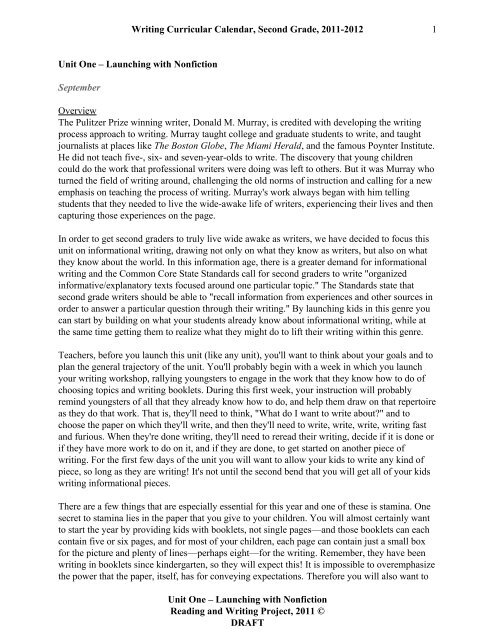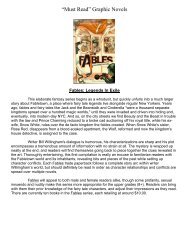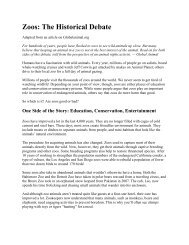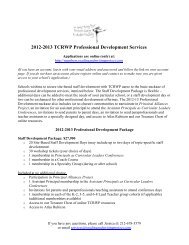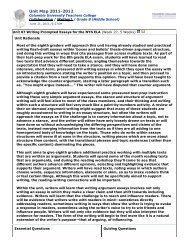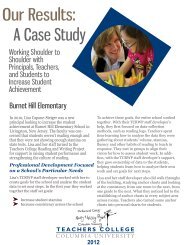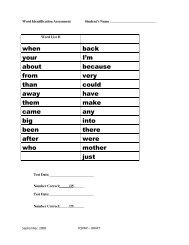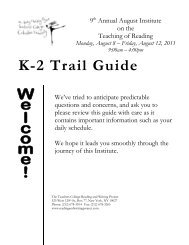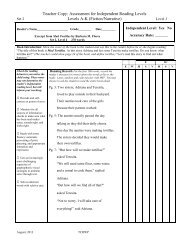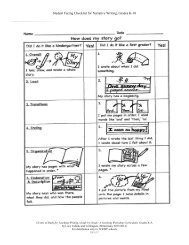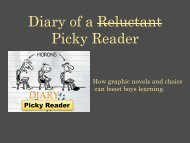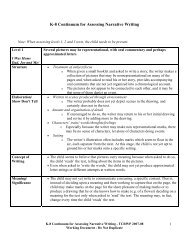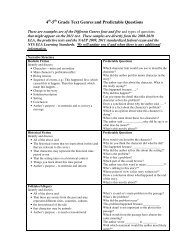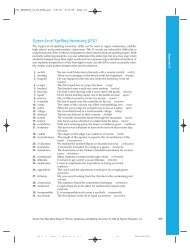2nd Grade Writing Unit 01 Launching with Nonfiction - The Reading ...
2nd Grade Writing Unit 01 Launching with Nonfiction - The Reading ...
2nd Grade Writing Unit 01 Launching with Nonfiction - The Reading ...
You also want an ePaper? Increase the reach of your titles
YUMPU automatically turns print PDFs into web optimized ePapers that Google loves.
<strong>Writing</strong> Curricular Calendar, Second <strong>Grade</strong>, 2<strong>01</strong>1-2<strong>01</strong>2 5<strong>The</strong> point in this bend is that one way or another, you need to be sure that you rally kids to notonly recall all that they have learned and to get started doing that work again, but also to work<strong>with</strong> zeal toward new and ambitious goals. It will also be important to notice where in theprocess students tend to get stuck—and to teach them how to get past that impasse. Childrenneed to know how to come up <strong>with</strong> story ideas or topics to write about, to get started, write,finish, reread, revise, and get started on another piece, all <strong>with</strong>out needing teacher-involvement.<strong>The</strong>y need to be problem-solvers in their own writing. You might say, "When writers are stuckand don't know what to do next...we think over our list of all the stuff we know how to do, andwe solve our own problems!" That is, children need to be able to cycle through the writingprocess <strong>with</strong> independence, leaving you free enough to teach. If children are asking "Can I bedone <strong>with</strong> this book and start another?" or "Can I get another sheet of paper?" refrain fromanswering these questions and instead coach writers to generate their own logical answers. Or atleast say, "Of course. You do not need to ask me. You are the writer! You are the boss!"Second <strong>Grade</strong> Writers Work <strong>with</strong> Partners in Grown-Up Ways, Helping Each Other to ShareInformation EffectivelyYou will have begun the year, teaching kids that they can draw on all they already know to writeas well as possible, and inviting them to get going on their writing. After a week or so of suchwork, children will be ready for the unit of study to take on a new emphasis. <strong>The</strong>re is no one waythe unit could unfold—no set in stone progression to the unit—but our thinking is that if this yearis going to maximize your students' potential, you will want to rally them to work in increasinglypowerful ways <strong>with</strong> each other. One of Murray's key articles is titled, "<strong>The</strong> Other Self" and itsuggests that when novice writers regularly read each others' writing, thinking about ways thatanother person's writing could be made even stronger, then writers learn to eventually becomereaders of their own writing, rereading their emerging draft, asking, "What's working that I couldbuild upon?" and "What's not working that I could repair?" We suggest, then, that this secondbend in the road of this unit might rally students to invest in partnership work to an extent whichis deeper than they've experienced before. While supporting those partnerships, you can helpstudents use partners to scaffold their engagement in the writing process. That is, whileostensibly supporting writing partners, you can actually support students' engagement in theprocess of writing. "Partners help each other plan writing," you can say." Partners also help eachother revise writing.After drumming up independence and confidence in the first week of second grade, allowingyour students to write across genres of their choice, you will then want to shift the focus of thisunit to informational writing. <strong>The</strong>refore, while you tap into the repertoire of strategies that thestudents in your classroom already know, you will want to do so in ways that lift the level ofinformational writing in the room. You might start this bend by validating the various genres thatthe students chose to write in during the initial bend, and then you might say, "Now that you aresecond grade writers, you not only know so many things about writing and what it takes to be astrong writer, but you also know so much about the world around you. You have learned somuch in kindergarten and first grade, and so I thought it would be fun to spend the next couple ofweeks writing informational books to teach others all that you now know."As mentioned above, the Common Core State Standards call for a strong emphasis on<strong>Unit</strong> One – <strong>Launching</strong> <strong>with</strong> <strong>Nonfiction</strong><strong>Reading</strong> and <strong>Writing</strong> Project, 2<strong>01</strong>1 ©DRAFT
<strong>Writing</strong> Curricular Calendar, Second <strong>Grade</strong>, 2<strong>01</strong>1-2<strong>01</strong>2 6informational writing, so we think it's a good idea to get your students writing nonfiction textsright off the bat. <strong>The</strong> challenge when teaching this unit is to make sure that you are not simplygiving students another month to write informational books, but that you are also ramping up thelevel of their informational writing. You will want to be sure that students enter this school yearrealizing that the expectation is not just that they dutifully fill up the pages of their booklets <strong>with</strong>facts that they know, but that instead, the expectation is that they actively, purposefully, worktoward making their writing better and better. You will want to acknowledge the All-about andexpert books that your students wrote in kindergarten and first grade, while at the same timeletting them know that as second grade writers they will be learning how to make these bookseven stronger. <strong>The</strong> writing students were able to do at the start of the school year—say, in theirfirst on-demand informational assessment—is the starting line, and each week, each month, thereshould be visible evidence that each student's writing has improved. It is especially importantthat now, at the very start of the year, each child sees his or her writing getting better, day byday, week by week, because if students start the year, seeing themselves outgrowing their oldselves in ways that are visible, then they'll develop expectations for that growth curve being thestatus quo for second grade.You might, for example, begin this portion of the unit by telling your students that you knowthey are accustomed to working <strong>with</strong> writing partners, but that you wanted to teach them thatgrown-up writers actually use partners in a really special way, and you thought maybe, justmaybe, there would be a few second graders who might be ready to use partners like theprofessional writers do. Of course, your entire class will be on their knees, insisting they're gamefor this, and <strong>with</strong> that drum roll you could point out the truth which is that grown-up writers lookhard to find writing partners who help us become better as writers. We know that a writingpartner who isn't just a "pat on the head, Good Girl" partner, but who says, "You can do evenmore than this!" and helps us to do that, is worth a million.It is important to recognize why writing partnerships are important, and you will want yoursecond grade writers to get this sense too. Partners can make pieces of writing—andwriters—better. To make sure this happens, you will want to give your students strategies thatallow their work in partnerships to pay off. You can teach students to take the responsibility oflistening to each others' work (and their own work) really seriously. Perhaps in partnershipmeetings, the writer will read aloud his or her writing, while the partner carefully listens andlooks on <strong>with</strong> the reader, offering suggestions to improve readability. You might, for instance,illustrate what you don't expect partners to do by showing what a disinterested partner mightlook like (leaning back in his or her chair, eyes scanning the room, yawning) and contrast that<strong>with</strong> a pantomime of an interested partner.In this bend, you will not only teach behaviors that allow for effective partnerships, but you willalso want to teach strategies to help your writers lift the informational books they are writing.You will want to recognize what your children have already learned while writing All-aboutbooks in kindergarten and first grade, so that you are acknowledging how you expect so muchmore now that they are second graders. Instead of teaching one way that partners can help oneanother to elaborate on a topic, you will want to teach your writers to ask questions to oneanother in order to prompt places where more elaboration is needed. This is a good time to teach<strong>Unit</strong> One – <strong>Launching</strong> <strong>with</strong> <strong>Nonfiction</strong><strong>Reading</strong> and <strong>Writing</strong> Project, 2<strong>01</strong>1 ©DRAFT
<strong>Writing</strong> Curricular Calendar, Second <strong>Grade</strong>, 2<strong>01</strong>1-2<strong>01</strong>2 8Preparing for PublicationWhile focusing on content and trying above all to be sure your children are writing up a storm,you’ll want to notice your children's spelling development, their command of the conventions ofwritten language, and their stance towards writing conventionally. For now, you will see thatsome children write <strong>with</strong>out a lot of concern for spelling, even the words they almost knowcorrectly. Others obsess about spelling every word correctly, wanting your seal of approval forevery decision. You need to be sure that you differentiate your instruction, helping those lessconcerned <strong>with</strong> spelling to take that extra second to remember to write correctly in upper orlowercase, pausing to spell word wall words correctly, and inserting end punctuation as theywrite. Alternatively, you'll want to help the children who see writing as little more than anexercise in spelling and penmanship to focus much more on writing quickly, fluently, <strong>with</strong> morefocus on content. For all children, remember that rough draft writing is not supposed to beperfect, and that as children grow older and more experienced as writers, more and more writingskills will become automatic and effortless for them.At the end of the unit, children will choose their best work and they will revise more deeply andextensively, <strong>with</strong> help from you. One of the best ways for your writers to do this final revisionwork is to act as though they are teaching someone all about their topic. You might teachstudents to act as teachers when they get together <strong>with</strong> their partners to share the information intheir books. In this role of "teacher", the writer will need to be prepared to respond to questionsthat his or her partner might have around the topic being taught. This will allow the writer tonotice whether or not the information he or she has includes the most important things thatsomeone might want to know about their topic. You will want to prompt the partners to stop theteachers to say, "But I don't understand? I don't know anything about soccer, and you mentionthat you need shoes to play, but will any old shoes work? What kind of shoes do soccer playerswear? What makes shoes special and important to the sport?" This work aligns nicely <strong>with</strong> theCommon Core State Standards in second grade where students are expected to ask forclarification and further explanation as needed about the topics under discussion, they are alsorequired to ask and answer questions about what a speaker says in order to clarifycomprehension, gather additional information, or deepen understanding of a topic. This revisionprocess can last for a few days, and it can, if you’d like, involve taping flaps of paper onto thebottom or the sides of a draft, using staple removers to open books up so that one page can beremoved and a new one substituted, and so forth. Children will appreciate revision more if youmake this as hands-on as possible. <strong>The</strong> Craft of Revision book from <strong>Unit</strong>s of Study for Primary<strong>Writing</strong> can give you additional ideas for minilessons during this portion of your unit.After children revise their selected work, they will need to edit it. You will presumably alreadyhave a word wall featuring a dozen high-frequency words, and if you haven’t done so already,teach your children that writers reread, checking to be sure they use word wall words correctly.Having taught this, from now on, throughout the whole year, you will want to remind childrenthat they know how to do this and they can do it <strong>with</strong>out explicit instructions from you. Here onin, after a child writes a draft of any story (even if the writer is not on the verge of publishing it)the writer needs to reread the text, checking that he or she spelled the word wall words correctly.<strong>Unit</strong> One – <strong>Launching</strong> <strong>with</strong> <strong>Nonfiction</strong><strong>Reading</strong> and <strong>Writing</strong> Project, 2<strong>01</strong>1 ©DRAFT
<strong>Writing</strong> Curricular Calendar, Second <strong>Grade</strong>, 2<strong>01</strong>1-2<strong>01</strong>2 9You will presumably also want to remind children to write <strong>with</strong> periods and capitals that signalthe endings and beginnings of sentences. This concept is not a simple one, and although theCommon Core State Standards expect that your students will have already gained command oversuch conventions in first grade, you will want to revisit this concept, particularly if you noticethat students are not regularly attending to such things in their writing. If needed you will want toremind your writers to think of a sentence as a thought, then to write that thought down in a rush,then add the period. Moving to the next thought, you will want to begin to write it using a capitalletter. <strong>The</strong> Common Core also expects that your writers will come to you already using commasto separate single words in a series, so again you might need to revisit this convention <strong>with</strong> thosewriters who have not yet grasped this concept, perhaps through small group instruction. Eitherway you address such conventions, be sure that these are not only seen as things to check whileediting as students get ready to publish, but rather these are important aspects of writing, andfrom this day on, your children will want to do this always when they write.Be sure you don’t get overly invested in making September’s published pieces perfect. Don’tfeel that the pieces themselves need to be more focused, more detailed, and more compellingthan they are. <strong>The</strong>se are little kids at the start of the year and their work will not be perfect. Ifyou prop the work up so that it matches your high standards, then the work will not representwhat your children can do, and later you and others will not be able to look at the progression ofpublished pieces to see ways in which children are growing. This is September, and much of thisunit has been consumed <strong>with</strong> empowering your kids to remember all that they come to secondgrade knowing how to do, so relax. You may choose to have your own private authorcelebration, and then hang the finished work <strong>with</strong>in the safe confines of your own classroom ifyou need to do so in order to let the children’s own work stand.We recommend the simplest possible publishing party so that you get onto the next unit by thestart of your second month of school. Perhaps just put writers into small circles where each onehas a turn to read aloud, <strong>with</strong> the listeners chiming in after each author reads. <strong>The</strong>n gather thekids alongside the bulletin board where each writer leaves his or her work in the appropriatesquare, perhaps saying, as he or she does, “I’m proud of the way I….” You could, alternatively,be the one to say what it is that you want to celebrate in each author’s piece.<strong>Unit</strong> One – <strong>Launching</strong> <strong>with</strong> <strong>Nonfiction</strong><strong>Reading</strong> and <strong>Writing</strong> Project, 2<strong>01</strong>1 ©DRAFT
<strong>Writing</strong> Curricular Calendar, Second <strong>Grade</strong>, 2<strong>01</strong>1-2<strong>01</strong>2 10Additional ResourcesAs you approach this unit, it will be important for you to read the entire write up, not just theteaching points and sample minilessons below, because, in the end, kids learn through the workthey do, and the write-up is jam packed <strong>with</strong> ideas, activities, and teaching to help you organizeand create opportunities for children to engage in work that matters. <strong>The</strong> unit write-up can helpyou issue the generous invitation that rallies kids not only to work <strong>with</strong> heart and soul, but alsoto engage in deliberate practice, trying to get better at specific skills that the unit aims tohighlight.In the end, a good portion of your teaching will revolve around the responsive instruction youprovide as you move kids along trajectories of skill development. This part of our teaching relieson you assessing your students often—not in big fancy ways, but by watching the work theydo—and on you seeing their work as feedback on your teaching. If you have taught somethingand only a handful of kids are able to sustain that work to good effect, then you’ll want to decidewhether that skill was essential, whether you want to reteach it in a new way, whether you wantto detour around it. You’ll want to become accustomed to fine tuning your teaching through anattentiveness to student work, because the work your students not only shows you what they canor can’t do, it also shows you what teaching moves YOU can do next.<strong>The</strong> sample minilessons included in this section were developed at a summer institute a few yearsago and have been adapted since then to meet the needs of the unit. A special thanks goes to allof those who contributed (you will find the main authors noted at the top of each one). <strong>The</strong>selessons are meant to help you think and reflect on this first unit of study and are by no means anall inclusive account of the unit. For the most part these lessons are aimed to get your kidsthinking about all that they already know as writers. Of course, you will need to see what yourstudents know as you assess the writing that they do on day one and throughout this unit, inorder to build on their repertoire. You will obviously need to add in many lessons (using thepossible teaching points below, alongside the work that your students are producing) especiallysince a major aim of this unit is to ramp up the informational writing that your students areworking on.One possible sequence of teaching points:Bend I: Writers Draw On What We Already Know to Write Up a Storm, <strong>The</strong>n We FindWays to Make Our Pieces Even Better!• Today I want to teach you that as second grade writers you already know what to doduring workshop. You can remember back to first grade and kindergarten and use allthat you know to come up <strong>with</strong> ideas for pieces of writing you want to make, to figureout what to do if you get stuck on a hard part or word, and how to revise your workwhen you are done. You don’t have to wait for a teacher to tell you what to do—you canuse all that you know. (Sample Minilesson A)• Today I want to teach you that when writers are trying to write long and strong we keepour mind thinking and our pen writing. (Sample Minilesson B)<strong>Unit</strong> One – <strong>Launching</strong> <strong>with</strong> <strong>Nonfiction</strong><strong>Reading</strong> and <strong>Writing</strong> Project, 2<strong>01</strong>1 ©DRAFT
<strong>Writing</strong> Curricular Calendar, Second <strong>Grade</strong>, 2<strong>01</strong>1-2<strong>01</strong>2 12cooking) is the very best it can be. By Nancy Schroeder, Gregory, Marc Morrison, andAndrea Bodley (Sample Minilesson F)• Today, writers, I want to teach you that not only can you revise using strips and flaps toadd into your booklets, but also by trying a second draft! You might rewrite your entirebook or chapter inside your book. You could start from scratch, maybe <strong>with</strong> a new titleor idea, and rewrite your book or chapter, putting more power behind your words..• Today I want to teach you when we are trying to write books that we want others tolearn from, we can turn to books that we have learned from to notice what those writersdid, and we can use their writing to make our writing better.Bend IV: Preparing for Publication• Today I want to teach you that as you revise your best book you have to really think,“What else do I need to include in my book to help teach others and to show that I reallycare about my topic?” One thing you can do is meet <strong>with</strong> your writing partner to actuallyteach the information. <strong>The</strong>n you will see how your partner responds. We need to beprepared to respond to questions that our partners might have around our topic.◦ Tip: Your partner will be listening and asking questions like, “But I don’tunderstand. What do you mean?” or “Why is this important?” This will help younotice what other information to include!• Today I want to teach you that writers reread our writing like detectives. We search forwords that need to be fixed up and spelled better. As second graders, you already knowof many tools that can help you to do this. You can use the Word Wall, charts in theroom, what you already know about vowel patterns and chunks or you might even turnto books about your topic to help you spell words the best that you can.• Writers use punctuation as we write to give directions to our readers when our thoughtor action ends and when a new one begins. When we edit our writing we will want tolook at how we used punctuation to make sure that our thoughts and ideas are clear tothe reader. Today I want to teach you to read your work carefully—like adetective—thinking about what changes you need to make.◦ Tip: Remember that a sentence is a thought. At the end of that thought is aperiod. <strong>The</strong> next thought begins <strong>with</strong> a capital letter. As we reread our work weread on the hunt for parts that we want to edit—and we use punctuation in abetter and clearer way.Sample Minilesson ABy Lucy CalkinsConnectionWriters, you must be feeling so grown up. Do any of you remember the first time you ever cameto school and you weren’t sure where to go, or what to do? You were probably standing there,thinking, “Where do I go?” “What do I do?” It must feel so different this year, right? How manyof you, when you got off the bus, had to just stand there and ask, ‘What do I do?” “Where do Igo?” Well, right now we are starting our writing workshop and I have HUGE news to tell you.This is it. You already know what to do. And you don’t have to sit there and ask, “What do I<strong>Unit</strong> One – <strong>Launching</strong> <strong>with</strong> <strong>Nonfiction</strong><strong>Reading</strong> and <strong>Writing</strong> Project, 2<strong>01</strong>1 ©DRAFT
<strong>Writing</strong> Curricular Calendar, Second <strong>Grade</strong>, 2<strong>01</strong>1-2<strong>01</strong>2 13do?” You can get started on writing, just like you can figure out how to get off the bus, go to theplayground, line up, come into our rooms.Teaching PointAs second grade writers you already know what to do during workshop. You can remember backto first grade and kindergarten and use all that you know to help you come up <strong>with</strong> ideas forpieces of writing you want to make, to figure out what to do if you get stuck on a hard part orword, and how to revise your work when you are done. You don’t have to wait for a teacher totell you what to do—you can use all that you know.TeachingLet me remind you what you of something you already know. After our minilesson, it will betime for you to write, and I’ll say, “So Table one, you can get started. Table two, you can getstarted.” If I had said that to you when you were a kindergarten student, what would you havedone? Right now, pretend it’s three years ago and you are five, and it is the start of writingworkshop, and I’ve said, “You can get started on your work.” What would you have done?Thought? (I act out a 5 year old, startled, paralyzed, and invite the kids to join me.)But you aren’t in kindergarten, are you? You are in second grade. So when I tell you, “You canget started on your writing,” picture what you’ll do….Make a movie in your mind of yourselfdoing that.I wonder if some of you are picturing that you’ll look for the kind of paper you want to write on.I bet some of you are deciding on booklets <strong>with</strong> three pages, some on booklets <strong>with</strong> fivepages….Are any of you picturing that you’ll choose your paper? Are you? You aren’t just sittingthere frozen going, ‘Huh?’ You are getting yourself started? Great.And are any of you picturing yourself thinking, “Hmmm, what will I write about?” and decidingyou’ll remember true stuff you’ve done? Are you?…..Are ideas already coming to your mind,<strong>with</strong>out a teacher telling you what ideas to have? You can think about stuff you are dying to tellpeople, right? And you can think about times you’ve had strong feelings.And…I know this is a long shot…but are any of you remembering that if you have a watermelonidea, like ‘the day at the beach,’ you can think about a small seed idea…. like ‘when a sea gullate half my hot dog.’So writers, do you see that just like you already know how to get off the bus and make your wayto the playground and to the classroom….you also already know how to write? And that meansthat from this day on, all this year long, you can get going on your writing, showing all that youknow how to do.Active InvolvementSo right now, will you picture what is going to happen when I say, “Table one, will you getstarted on your writing?” Picture what kind of paper you are going to take from the pile…pictureyourself thinking about a story you are going to write…Remember back to first grade to help youout. What are all the things that you are going to do in workshop today? Turn and tell your<strong>Unit</strong> One – <strong>Launching</strong> <strong>with</strong> <strong>Nonfiction</strong><strong>Reading</strong> and <strong>Writing</strong> Project, 2<strong>01</strong>1 ©DRAFT
<strong>Writing</strong> Curricular Calendar, Second <strong>Grade</strong>, 2<strong>01</strong>1-2<strong>01</strong>2 14partner.Have your kids turn and talk. Listen for all the things that they remembered from first gradeabout workshop and writing. Let them talk for a minute or so and bring them back to the wholegroup.Second <strong>Grade</strong> writers, I listened to you talk and share <strong>with</strong> your writing friends about what youlearned last year in first grade. Wow! I heard you say lots of things! You must have really beenpaying attention because I was amazed at all you have learned. I could go on and on and onabout it. One important thing I heard was that you learned how to pick what to write about. Iheard you say you learned that you can write about things from your own life, your ownexperiences. Turn right now to a writing friend and talk about some of the things in your own lifeyou could write about.Have your kids turn and talk once more briefly. This will help them generate ideas and get astrong start when they go back their writing spots. Listen for a few examples that you couldshare <strong>with</strong> the rest of the class.LinkWriters, let me stop you. I heard some of you say that today you want to write about the specialpeople in your lives, like your family and friends. Some of you are going to write about yourpets, a play date, and swimming at the pool. I even heard someone say, ‘I’m going to write allabout my karate class!’ Yikes! you all have a lot of books to write.You have years of experiences swirling around in your 7 and 8 year old minds just waiting to bewritten about. I know that you don't need anyone to tell you what to write about. I know youwon't need to ask anyone what to write about because each of you is the one who knows thesethings. You were there. You are the one who saw stuff happen. You are the one who felt thefeelings when those things were happening. You may have heard sounds and you may have evensmelled smells—you are the one who was there. Even if someone in this room was also there,you had your own experience!So guess what writers?! You are the boss of your own writing! Today is the first day ofworkshop and you have lots of ideas of books that you want to write. You learned so much lastyear that you are now experienced writers who know what you can write about. Don’t forgetthose things! Use all that you know to help you as a writer. You have the ability to replay whathappened like a movie in your mind. So writers, get going!Sample Minilesson BBy Carol Cook, Erin Heimane, Cathy Davidson, & Chris ZarkwoskyConnectionWriters, yesterday, you blew me away <strong>with</strong> all that you remembered about what writers do! Istood back and said to myself, “Wow, look at the way they are getting started <strong>with</strong>out me tellingthem what to write!” I just said, “Go to it!” And then all of you did just that. Impressive. Our<strong>Unit</strong> One – <strong>Launching</strong> <strong>with</strong> <strong>Nonfiction</strong><strong>Reading</strong> and <strong>Writing</strong> Project, 2<strong>01</strong>1 ©DRAFT
<strong>Writing</strong> Curricular Calendar, Second <strong>Grade</strong>, 2<strong>01</strong>1-2<strong>01</strong>2 15writing workshop this year is going to be so much fun.After school, when the room was empty and quiet, I started thinking, “<strong>The</strong>se writers are sooogrown up.” You got started on your own stories, letters, and information books in really grownup ways. When I looked at your writing, I saw that many of you know how to choose paper likegrown up writers, you know how to find your own topics like grown up writers, and you knowhow to start your stories all on your own like grown up writers. <strong>The</strong>n I saw that most of you hadabout a sentence on each page. I thought to myself, that is different than grown up writers.Grown up writers have a paragraph on each page. Not just one sentence.You may want to take out two different books: an early leveled book, like a level C book and apicture book like Vera’s First Day of School. You can show children the difference.As second grade writers we are ready to move from writing books like this (hold up the level Cbook) to books more like this one (hold up the picture book that has a paragraph on the firstpage).Teaching PointToday I want to teach you that when writers are trying to write long and strong we keep ourmind thinking and our pen writing. <strong>The</strong>re are a few things that we need to remember: Make aquick sketch, think about all that is happening on the page. Once you get one thing down on thepage, keep your mind and pen thinking. Try to think of another thing to write until you fill thepage. If you need more lines, remember to tape on a flap. <strong>The</strong>n turn the page.TeachingWatch me and notice how I get a paragraph of thought written on the page. Watch how quickly Isketch and how I keep my pen writing and my mind thinking. I am going to try to not just writeone sentence on the page, I’m going to keep thinking of more that I have to say, before I turn thepage.Since in this first part of the unit, students have a choice of which genre to write you will have todecide what you will demonstrate. We recommend an information book. Show your students howyou start on chapter one to generate a paragraph about your topic. You will want to show themabout 3-5 sentences that you can write about one page. Give them tips along the way.So I am writing my first chapter to my information book about Basketball. My chapter is called“Playing Defense.” Now let me get my quick sketch on the page.Now what will I say? Let’s see. “Playing defense in basketball is not easy.” Am I done? Nopethat is just one sentence, I have to keep my pen writing and mind thinking! Let me look up at thesketch to see what else I can say about playing defense. Hmmm... I guess I could say what I dowhen playing defense in basketball. So I could write, “ You have to keep your arms up.” Do yousee here in the picture how I have my arms up? What else do I do? I have to keep thinking. Oh! Ialso stare at the ball. I keep my eyes on the ball. And I bend my knees and move <strong>with</strong> the player.Wow! That’s two more things! Let me write that down quickly!<strong>Unit</strong> One – <strong>Launching</strong> <strong>with</strong> <strong>Nonfiction</strong><strong>Reading</strong> and <strong>Writing</strong> Project, 2<strong>01</strong>1 ©DRAFT
<strong>Writing</strong> Curricular Calendar, Second <strong>Grade</strong>, 2<strong>01</strong>1-2<strong>01</strong>2 16Did you see how I sketched quickly and then I got right to my writing? I kept my mind thinkingand pen moving? I kept thinking, “What else, what else?”Active InvolvementWriters, lets’ try this all together in our class All-About Book about School. Let’s work on thechapter, “Time for Food,” about the cafeteria. Let’s try to keep the pen moving and our mindsthinking! Are you ready? Turn and tell your partner not just one thing but many things we caninclude on this page. Let’s get a paragraph!(You may want to voice over tips to help kids think such as: “Look up at the picture,” “Thinkabout what else you could say,” “Think about what else happens...”)LinkWriters, each day when you write, remember that now you are ready to write longer stories,letters, and chapters in your All-about books or in your stories. You can do that by thinkingabout spending most of your time writing. When you go off to write today remember, lets’ writelong and strong! Keep your pens moving and your minds thinking! When you are done <strong>with</strong> onepage remember, before you turn the page, look at it and say, “What else can I say here? Do Ihave a paragraph?”Mid-Workshop Teaching PointWriters, can I stop you for a minute? You must see Beth’s writing! (Hold up a page or two <strong>with</strong>a good bit of writing.) So cool! She has spent almost all her time writing. When we looked ather piece together Beth told me that she was trying to add more to the page. She added more bythinking about what her dad was saying and also what she was saying and doing. Let me readjust this one page that she added 5 sentences to. (Read the student work.) Not only does she saymore, but as a reader I can see more! I really see Beth and her dad at the picnic together! Ok, getback to it, writers. You have about 15 more minutes to get more thoughts on your paper.Remember, when you add more to your writing it helps the reader see and understand more.Sample Minilesson CBy Lucy CalkinsConnectionWriters, do you realize we have only been in school for a few days? I think that if we made a listof all the stuff you do as writers, it would be taller than most of you!You might select a student to dramatize just how long this list will be. Turn that way, Marco,we’ll make our list alongside your back. Let’s see, hmmm. (I reach down to the back of Marco’sshoes and start making my hands crawl up his backside, as if we were singing the itsy-bitsyspider song and the spider was climbing up the water spout. I make a large hand-size step up foreach new item as my goal is to reach his head.) We learned…· that writers can think, “What are the cool things I’ve done that I’m dying to tell people<strong>Unit</strong> One – <strong>Launching</strong> <strong>with</strong> <strong>Nonfiction</strong><strong>Reading</strong> and <strong>Writing</strong> Project, 2<strong>01</strong>1 ©DRAFT
<strong>Writing</strong> Curricular Calendar, Second <strong>Grade</strong>, 2<strong>01</strong>1-2<strong>01</strong>2 18hand gesture) “Help me, help me, I don’t know what to do.” You know what I’m going to say tomyself? (I look around to see if the kids are gesturing to show they have their list, or calling itout.) You are right! I’m going to say, “Lucy you don’t need to say, ‘Help me, help me,’ you cansay, ‘I’m going to solve this myself’” (and I draw my imaginary list out of my pocket, holding itas high as Marco’s head). <strong>The</strong>n I will think about all the stuff I know how to do…and pretty soonI’ll remember,“Wait, when you come to a word you don’t know, you can write it as best you canand I’ll start stretching out ‘boa constrictor’ to hear the parts of those words, right?”So, you see writers, you don’t have to say, “Help me! Help me! I don’t know know what to do!”You can take out the list of things that you know! You can use our charts in the room to help youwhen you get stuck in your writing.Active InvolvementBut, oh my goodness, what if I finished writing my story about that trip to the zoo? What if Iwas done? And what if I knew I could start a new story but I wanted instead to revise mystory….and what if I didn’t know what I should do to revise, and I started to go to the teacherand…(I’m just about to reenact the ‘Help me’ pose but cut myself short to instead pass the batonto the children.)Let’s pretend. Partner One, you are going to ‘act stuck’, like you don’t know what to do to reviseyour story. You are so so needy, and you just want someone to tell you what to do. Will you askPartner Two for help in your most whiney squeaky little weak-knee-ed voice? Partner Two, yourjob is to remind partner one what she or he can do. How can your partner use his or her own listof things that can help, as well as the lists in our classroom?Partner One, remember, you just finished your story about the trip to the zoo, and you are reallystuck and needy—pretend—Go!Over the hubbub, I called, “Partner Two, help Partner One. Don’t tell Partner One how to revise!Remind her what she can use to help get herself ‘unstuck!’ ”LinkSo writers, you now have one more thing to add to your list of what you know how to do. Youknow how to solve your own problems! (And I pull out an imaginary list.) If any of you want atiny version of our list of things you have already learned to do, I have put some of those lists onthe middle of each table.Think about the work you are going to do today. How many of you are adding on to your story,letter or All-about book? How many are doing what real authors do and revising? Will some ofyou be starting another story or letter? Okay—those of you who are starting a new story, letter orinformation book, will you get started? Will those of you who are going to be revising yourbooks and letters you just finished, or even books that you wrote earlier this week, get started?Let’s the rest of us watch to see if these writers start by rereading and thinking to themselvesabout their ideas for what they could do. <strong>The</strong>y might even put Post-its on each page to tellthemselves their ideas for making that page better. <strong>The</strong> rest of you can get started.<strong>Unit</strong> One – <strong>Launching</strong> <strong>with</strong> <strong>Nonfiction</strong><strong>Reading</strong> and <strong>Writing</strong> Project, 2<strong>01</strong>1 ©DRAFT
<strong>Writing</strong> Curricular Calendar, Second <strong>Grade</strong>, 2<strong>01</strong>1-2<strong>01</strong>2 19Mid-Workshop Teaching PointWriters, can I have your eyes up here? I loved watching you guys solve your own problemstoday! How many of you have been acting like weak and a little needy ‘Help me, help me’writers today? None of you?! That’s what I thought! And we still have twenty more minutes ofwriting time. How many of you think you will be able to keep yourself busy doing cool stuff forthat whole time? Thumbs up if you think you’ll be able to give yourself work to do, and youwon’t need to get into that ‘Help me, help me’ stuff. Right now, will you each tell your partnersome of the stuff you are hoping to have time to do during the rest of today’s writing workshop,and see if you all can not only give yourself ideas for what to do but can even give each otherideas.Writers, can I stop you? I know you haven’t each had time to talk yet, but I am pretty sure youcan talk this out to yourself, so will you finish whatever you are saying and get started doing allthis important work? And if you didn’t have a chance to tell your partner what you plan to do,tell yourself your plans before you get started doing them. <strong>The</strong>n you can get back to work.Teaching ShareWriters, it is really helpful to talk over the work that you do. Right now, let’s talk over the workthat Jeremy did as a writer today, and think <strong>with</strong> him about the work he could do next. <strong>The</strong>nwe’ll do the same talking-over <strong>with</strong> our partners. This is Jeremy’s writing (I project an enlargedversion of it, and read it aloud in a way that does not cast judgment on it, but doesn’t make itsound absolutely perfect and done either). Jeremy, can you point out some of the things you weretrying to do to make this a great story, and show us where you did them?Jeremy talks about how he added details and I pull from him why he was adding those details,and where he added them, and how he went about coming up <strong>with</strong> details. <strong>The</strong>n I ask, “Whatelse were your trying to do?” and when he runs low of intentions, I quiz more specifically,“What were you trying to do at the start of your story?” <strong>The</strong>n I ask the other children to talk toJeremy about what they noticed, and other ideas they had for what he might possibly try. Whenchildren are too commanding about what he has to do, I caution them that Jeremy would need, inthe end, to decide for himself. <strong>The</strong>n I channel all children to work in a similar way to think aboutPartner One’s writing, starting <strong>with</strong> Partner One talking about what he or she wanted to do, howhe or she tried to do that, making sure the writer talked about more than one intention.Sample Minilesson D*By Raquel Yohai*You will want to design your Teaching, Active Engagement, and Link to support students inthinking about their ‘plans’ in writing.ConnectionGood morning, writers. I have been studying and watching you play <strong>with</strong> your silly bands. Ofcourse I notice that you have so many cool ones—pink cotton candy, enormous elephants, bluefishes.... But what I am really noticing is that many of you seem to actually plan out how you can<strong>Unit</strong> One – <strong>Launching</strong> <strong>with</strong> <strong>Nonfiction</strong><strong>Reading</strong> and <strong>Writing</strong> Project, 2<strong>01</strong>1 ©DRAFT
<strong>Writing</strong> Curricular Calendar, Second <strong>Grade</strong>, 2<strong>01</strong>1-2<strong>01</strong>2 20make a collection that isn't just good....but that is great.Like Sasha, am I right that you looked over your silly bands and decided that you would make acollection of pink silly bands, so you traded away your green ones, and now almost all of yoursare pink? Is that right? And am I right that there’s at least one silly band collection which is allanimal stuff....is that right?Well, what I want to tell you today is that what you are doing <strong>with</strong> your silly bands is the samething that professional writers do when we write all about books, letters and stories. I know youguys are only eight, and you aren't exactly professional authors yet...but the work you are doing<strong>with</strong> your silly bands is so grown up and so writerly, that I wonder if you'd be willing to trydoing the same sort of stuff <strong>with</strong> your books and letters. You game?Teaching PointToday what I want to teach you specifically is that writers don't just put together any old pieceand then say, "I'm done." No sir-y! You know how you look at your silly band collections andthink, “How can I make this go from good to great?" Well, writers ask the same thing when welook at our stories, All-about books, and letters. We ask, “How can I make this go from good togreat?” And the secret to making our writing go from good to great is something you guysalready know because it is what you do <strong>with</strong> your silly bands. <strong>The</strong> secret is that writers plan. Weeither sketch it, tell it, or even jot a couple of notes about what we will write. This helps us to getour ideas and words organized and clear before we start writing or revising.(Teachers, we invite you to create your own teaching, active involvement and link, based on yourown writing plans and writing project.)Sample Minilesson EBy Antonella Della Gala, Lynette Vieira & Hindie WeissmanConnectionWriters, you know Mrs. Phelps and I are exercise partners, right? Well, we work together so thatwe can become stronger. (I demonstrate a muscle man gesture). You know the other day wewent down to Crystal Cove and Mrs. Phelps said to me, "Look, we walked up to Trader Joe's lastweek and I noticed that you didn't get tired. I think we can go a little farther today." I said,"Okay."Guess what happened when Mrs. Phelps said to me, "You can do it!” I did go farther and I gotstronger. Next week she's probably going to try to get me to go even farther.Teaching PointWell, guess what, writers? Writers have partners to help us do just the same thing. Today I wantto teach you that partners help each other become stronger writers. We help each other not justby noticing how much our partner has become a stronger writer but what kinds of goals we canset together. Just like Mrs. Phelps helped me, you can help your partner become a stronger writerand set ambitious goals together.<strong>Unit</strong> One – <strong>Launching</strong> <strong>with</strong> <strong>Nonfiction</strong><strong>Reading</strong> and <strong>Writing</strong> Project, 2<strong>01</strong>1 ©DRAFT
<strong>Writing</strong> Curricular Calendar, Second <strong>Grade</strong>, 2<strong>01</strong>1-2<strong>01</strong>2 21TeachingPresley, would you mind being my partner today? Writers, would you all watch while Presleyand I work together so that we can become stronger writers. Presley, let’s look at your worktogether. Now watch as I notice some things that Presley has done. Presley, I noticed that sincethe beginning of the year your booklets have grown from two pages to four pages. Am I right?Wow, that’s double.Now I am going to help Presley by thinking about a new goal for his writing, to help him geteven stronger! Just think, three weeks from now, I can imagine your books will grow evenlonger… maybe they will be even eight pages. Wow! I think you can do it, don’t you? Thatseems like a big goal, but a good one! You want to try to work towards that goal?Did you see, writers, how I thought about what Presley had accomplished and we set a goal forwhat he could work on?Active InvolvementWriters, now I want you to pull out your folders. Partner One will you look at your partner’swork and see how much his or her writing has grown. Tell your partner what you have noticed.<strong>The</strong>n set a goal together!After a few minutes have Partner Two do the same. As the children are looking at each other'swork and talking, this is a time for you to listen in on their conversations. In a minute or so youwill want to share out what a couple of partners noticed and the goals that they set.LinkWriters, you have a lot to say to one another! Great job. I bet you want to keep going <strong>with</strong> thiswork. Remember that any time you work <strong>with</strong> a partner you are trying to help that personbecome stronger! You are helping your partner write the best she can so that the reader of herwork will be able to know as much as possible. One thing you can do is look over each other’swork and tell your partner about what you notice about how she has grown as a writer. <strong>The</strong>n youtwo can make plans and goals together to help you get even stronger. Okay, now off you go towriting!Sample Minilesson F-By Nancy Schroeder, Gregory, Marc Morrison, and Andrea BodleyConnectionWriters, last night when I was making stir fry for my friends, I finished and said "Phew, I amdone!" <strong>The</strong>n I tried a little taste and said, "This tastes good...but I bet it can be even better.What can I do to make it taste even better, so that my friends are really impressed?" I looked inmy refrigerator to see what else I had and I found some peppers. I chopped up the peppers andtossed them into the pan. I stirred it up and took a taste. "Mmmm, this is good!" I thought. Butcould it be even better? Maybe I could add just a little bit of salt." I shook some salt into the pan,stirred it again, and took another taste. "YUM!" I said. "This is amazing! My friends will be soimpressed. I'm so glad I decided to add those peppers and that salt!"<strong>Unit</strong> One – <strong>Launching</strong> <strong>with</strong> <strong>Nonfiction</strong><strong>Reading</strong> and <strong>Writing</strong> Project, 2<strong>01</strong>1 ©DRAFT
<strong>Writing</strong> Curricular Calendar, Second <strong>Grade</strong>, 2<strong>01</strong>1-2<strong>01</strong>2 22<strong>The</strong>n I thought, "Hey, this is just like what writers do! When they finish a piece, just like Ifinished my stir fry, they can change things to make their writing better." We call this revision.Show a thumbs up if you've been revising your writing already this year. I know you know allabout revision. Well, writers, as you know, are constantly revising their work.Teaching PointToday, I am going to teach you that writers are like cooks. Whenever good cooks think they'redone, they taste their food and think about what else it needs. Writers, we do the same thing! Wedon’t say we’re done—we read our writing to decide what we can do to make it better. We addthings, we take things away, and we change things until our writing piece (like our cooking) isthe very best it can be.TeachingLet's try this <strong>with</strong> our All-about book about School. I know that you already know how to dothis, but watch me as I try it first. I'm going to "taste" the piece first by re-reading it. (Read thechapter aloud.) Well, that was pretty good! But I bet it could be even better. Hmm. What can Ido? I know, I could add labels to the picture. Okay, that's better. But what else could make itbetter? I could add some more information by adding another sentence to go <strong>with</strong> this one,maybe. Oh, and this part doesn't really make sense here—I'm going to cross it out to rewrite thatsentence. It looks like I am going to need a revision strip to add to the middle.(Turn and lean in closer to the students.)Did you see that, Second <strong>Grade</strong>rs? I didn’t just say “I’m done!” I reread and said, “How can Imake this better?” I added to the picture, I added to the words, and I took out a part that didn’tmake sense. I also used a revision strip when I didn’t have room to add more details to my story.Active InvolvementNow it's your turn. Look through your writing folder and pull out a piece you've already finished.Read through the first few chapters and think about what you could do to make this piece better.Could you add more to the words? Are there some words that don't belong? Does it all makesense? (Give the students a few minutes to read.) Now please turn to your partner and share afew things that you already see that you could do to revise your piece. Partner A, please start.(Circulate, listen, coach.) Okay, now it's partner B's turn. (Circulate, listen, coach.)(You may decide that you want to share a couple of examples of things that students are decidingto do to revise their first chapter. If your students need more time, after you have shared anexample or two, have them to try again on the second chapter.)LinkI want you to remember that writers are like cooks—we don't just say "I'm done," we read ourwriting and think, "What can I do to make my writing even better?" Today and every day, whenyou finish a piece of writing, re-read it to see what you can do to make it better—revise it! Let'swatch as Table Group One returns to their desks and begins revising their writing...Wow. Did<strong>Unit</strong> One – <strong>Launching</strong> <strong>with</strong> <strong>Nonfiction</strong><strong>Reading</strong> and <strong>Writing</strong> Project, 2<strong>01</strong>1 ©DRAFT
<strong>Writing</strong> Curricular Calendar, Second <strong>Grade</strong>, 2<strong>01</strong>1-2<strong>01</strong>2 23you see that? Did you see how they got started? Someone already started to add to her picture,another person got a revision strip to add more to the page. I bet someone else will be crossingout those parts that don’t make sense! Group One really went right to their desks and beganrevising. Okay, off you go writers.<strong>Unit</strong> One – <strong>Launching</strong> <strong>with</strong> <strong>Nonfiction</strong><strong>Reading</strong> and <strong>Writing</strong> Project, 2<strong>01</strong>1 ©DRAFT


